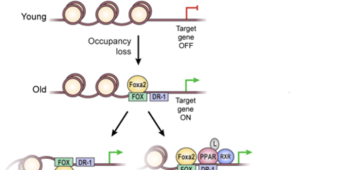Current projects in the lab include studying the role of pioneer factor Foxa2 in modulating chromatin accessibility for ligand-dependent activation of nuclear receptors (Project 1), investigating regulation of heterochromatin at the nuclear lamina in metabolic disease (Project 2), and pursuing novel regulators of liver metabolism (Project 3).

Role of pioneer factor Foxa2 in modulating chromatin accessibility for ligand-dependent activation of nuclear receptors (funded by R01 from NIDDK DK121059)
Foxa2 (forkhead box A2) is a pioneer factor that regulates chromatin accessibility by nucleosome depletion. Our previous work suggests that, contrary to the classical model of ligand-dependent nuclear receptor activation, additional Foxa2 binding in aged liver enables recruitment of nuclear receptors PPAR and LXR to adjacent ligand-dependent sites. In turn, nuclear receptor binding activates expression of lipid synthesis and storage targets that contribute to pathogenesis of fatty liver. We are pursuing the hypothesis that Foxa2 modulates chromatin accessibility changes that are essential for ligand-dependent nuclear receptor binding.

Investigating regulation of heterochromatin at the nuclear lamina in metabolic disease
Increasing evidence suggests that regulation of heterochromatin at the nuclear envelope is a common mechanism underlying metabolic disease susceptibility and age-dependent metabolic changes. We have shown that detrimental changes at the nuclear that accompany aging lead to increased binding of pioneer factor Foxa2 to sites repressed in healthy young livers, leading to de-repression of lipid synthesis and storage targets and culminating in hepatic fat accumulation. We are pursuing the hypothesis that heterochromatin dysregulation at the nuclear lamina also contributes to metabolic disease that is not associated with aging.

Pursuing novel regulators of hepatic steatosis identified by epigenetic changes in aged liver
A proteomics experiment to determine chromatin modifications present on histone tails in young and old livers identified two previously uncharacterized bivalent marks. We have performed ChIP-Seq experiments to pinpoint the genomic locations where the co-localization occurs. Motif analysis in sequences that were differentially occupied in bivalent domains in young and old (fatty) livers suggested new candidate transcription factors that could contribute to fatty liver disease.
